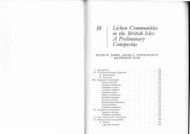You also want an ePaper? Increase the reach of your titles
YUMPU automatically turns print PDFs into web optimized ePapers that Google loves.
near desert region occurring or lacking, in the<br />
east European deciduous region lacking or<br />
culminating.<br />
subco = sub continental: East European<br />
deciduous forest region, east European boreal<br />
pine forest, westward to central Europe. Species<br />
lacking in west Europe.<br />
co = Continental: Steppes and semi-desert region<br />
<strong>of</strong> east Europe (and Asia). Species only isolated<br />
to advancing into the dryer region <strong>of</strong> central<br />
Europe. Continental boreal region.<br />
pralp = pre-alpine: Montane to high montane<br />
regions in the periphery <strong>of</strong> central-, east- and<br />
southeast European high mountains. The species<br />
seldom penetrating <strong>of</strong>ten also into the<br />
corresponding higher zones <strong>of</strong> the mountain.<br />
zentr = central Europe: Central Europe.<br />
Distribution focal point in central Europe, more<br />
or less clearly culminating in the periphery <strong>of</strong><br />
central Europe.<br />
oc = oceanic: Occurring in the lowlands <strong>of</strong> the<br />
near Atlantic region, decreasing toward the east<br />
in the interior increasingly up the mountain and<br />
only occurrence <strong>of</strong> isolated species (Attention: in<br />
the ecological characterization <strong>of</strong> the species the<br />
term oceanic is used only in the pure ecological<br />
sense: having an oceanic climate).<br />
4.5.2 Elevation Zones<br />
(Importance in region see p. 37)<br />
mo montane<br />
h’mo high montane<br />
subalp sub-alpine<br />
alp alpine<br />
4.5.3 Diagnosis <strong>of</strong> the Areas<br />
The statements made about the area <strong>of</strong> single<br />
lichen species in this book show only for Europe<br />
and use a rough orientation <strong>of</strong> the extent <strong>of</strong> the<br />
area. Often an extensive area is given as possible<br />
or probable. Thus many species distributed in<br />
Central Europe undoubtedly still occur in the<br />
montane region <strong>of</strong> the sub-Mediterranean or<br />
Mediterranean belts, even when the area<br />
diagnosis <strong>of</strong> these zones in not named.<br />
Statements about the zones were given priority.<br />
In many cases the vertical distribution and the<br />
east-west extensions is indicated; in this the<br />
Central European zone was especially<br />
considered.<br />
The area-zone statement in parentheses means<br />
that the species in the region concerned consists<br />
only <strong>of</strong> isolated occurrences. A continental<br />
designation <strong>of</strong> vertical zone in parentheses means<br />
that the corresponding distribution tendency<br />
exists or that the statement is relatively uncertain<br />
.<br />
Example <strong>of</strong> diagnosis <strong>of</strong> area:<br />
arct-mieur:<br />
The species occurs from the arctic to the<br />
Central European zone.<br />
bor-med:<br />
Occurring from boreal conifer forest into<br />
Mediterranean region.<br />
bor-mieur-mo:<br />
Occurring in the boreal and in the temperate<br />
(central European) zone, here however<br />
predominantly in the montane zone; for that<br />
reason in the southern part <strong>of</strong> the area mostly<br />
in definite distributional lacunae.<br />
arct-alp:<br />
Occurring in the arctic and in the alpine zone<br />
<strong>of</strong> the boreal to the Mediterranean zone. The<br />
area strongly disrupted (disjunct).<br />
arct-mieur-alp:<br />
Occurring in the arctic and in the alpine zone<br />
<strong>of</strong> the boreal and the Central European zone.<br />
mieur-subatl-med:<br />
Occurring in the sub-Atlantic region <strong>of</strong> the<br />
temperate zone over the sub-Mediterranean<br />
region to the Mediterranean zone. Thereby it<br />
is mostly though with a sub-Atlantic tendency<br />
in the sub-Mediterranean and Mediterranean<br />
region.<br />
A designation, which is separated by a comma<br />
from the remainder <strong>of</strong> the area diagnosis, covers<br />
the same area. Example:<br />
mieur-med, pralp:<br />
Occurring in the vicinity <strong>of</strong> the alpine<br />
mountains and in lower elevations <strong>of</strong> the<br />
mountains themselves, from the temperate to<br />
the Mediterranean zone.<br />
mieur-subatl-smed, oc:<br />
Occurring in the sub-Atlantic region <strong>of</strong> the<br />
temperate zone into the sub-Mediterranean<br />
region, toward the east where an increasing<br />
restriction to the mountains is observed.<br />
4.5.4 Habitat Remarks on Extent and Natural<br />
Uniformity/landscape<br />
Al Allgäu<br />
Av Foothills <strong>of</strong> the Alps (pre alpine hills<br />
and moors)<br />
Ba Baar<br />
25





